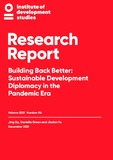Building Back Better: Sustainable Development Diplomacy in the Pandemic Era
| dc.contributor.author | Gu, Jing | |
| dc.contributor.author | Green, Danielle | |
| dc.contributor.author | Yu, Jiadan | |
| dc.coverage.spatial | China | en |
| dc.coverage.spatial | United States | en |
| dc.date.accessioned | 2021-12-16T11:44:48Z | |
| dc.date.available | 2021-12-16T11:44:48Z | |
| dc.date.issued | 2021-12-16 | |
| dc.identifier.citation | Gu, J.; Green, D. and Yu, J. (2021) Building Back Better: Sustainable Development Diplomacy in the Pandemic Era, IDS Research Report 86, Brighton: Institute of Development Studies, DOI: 10.19088/IDS.2021.065 | en |
| dc.identifier.isbn | 978-1-78118-896-5 | |
| dc.identifier.issn | 0141-1314 | |
| dc.identifier.uri | https://opendocs.ids.ac.uk/opendocs/handle/20.500.12413/17009 | |
| dc.description.abstract | This report critically examines the nature of the distinction between traditional inter-state diplomacy and sustainable development diplomacy. It then sets out the institutional changes which are necessary for the achievement of sustainable development diplomacy. Multi-stakeholder partnerships have been identified as a key means of implementation for the Sustainable Development Goals (SDGs). Given the increasing centrality of the United States (US)–China relationship in global development cooperation, understanding the modalities of their engagement may provide useful insights into how partnerships may be cultivated and deepened to realise the SDGs. The Covid-19 pandemic and climate change have demonstrated the interconnection of the world, as well as the interconnection of challenges of the world. Sustainable development diplomacy is needed now more than ever to prioritise development strategies of different states and work on common shared challenges. Sustainable development diplomacy can only work when different actors recognise the value of the common goals and are willing to make an effort to accomplish them. Global sustainable development diplomacy requires a stronger policy agenda and greater cohesion. This report explores the idea of sustainable development diplomacy and, through two sectoral case studies, explores the nature, function, and rationale for interactive engagement. The form and structure of multi-actor relationships are a response to complex, trans-border political, social, economic, and environmental challenges which require a more nuanced and varied management approach than narrowly defined state-led development. However, the power dynamics, the modalities, and experiences of engagement that underpin these dynamic relationships, remain understudied, especially with regard to their impact on sustainable development. | en |
| dc.description.sponsorship | Foreign, Commonwealth & Development Office | en |
| dc.language.iso | en | en |
| dc.publisher | Institute of Development Studies | en |
| dc.relation.ispartofseries | IDS Research Report;86 | |
| dc.rights | This is an Open Access report distributed under the terms of the Creative Commons Attribution 4.0 International licence (CC BY), which permits unrestricted use, distribution, and reproduction in any medium, provided the original authors and source are credited and any modifications or adaptations are indicated. | en |
| dc.rights.uri | http://creativecommons.org/licenses/by/4.0/ | en |
| dc.subject | Climate Change | en |
| dc.subject | Governance | en |
| dc.subject | Health | en |
| dc.title | Building Back Better: Sustainable Development Diplomacy in the Pandemic Era | en |
| dc.type | IDS Research Report | en |
| dc.rights.holder | Institute of Development Studies | en |
| dc.identifier.team | Business, Markets and the State | en |
| dc.identifier.doi | 10.19088/IDS.2021.065 | |
| rioxxterms.funder | Default funder | en |
| rioxxterms.identifier.project | Default project | en |
| rioxxterms.version | VoR | en |
| rioxxterms.versionofrecord | 10.19088/IDS.2021.065 | en |
| rioxxterms.funder.project | 9ce4e4dc-26e9-4d78-96e9-15e4dcac0642 | en |
Files in this item
This item appears in the following Collection(s)
-
IDS Research [1671]
Except where otherwise noted, this item's license is described as This is an Open Access report distributed under the terms of the Creative Commons Attribution 4.0 International licence (CC BY), which permits unrestricted use, distribution, and reproduction in any medium, provided the original authors and source are credited and any modifications or adaptations are indicated.


